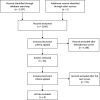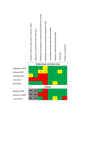Ketamine for the treatment of prehospital acute pain: a systematic review of benefit and harm
- PMID: 33234621
- PMCID: PMC7689093
- DOI: 10.1136/bmjopen-2020-038134
Ketamine for the treatment of prehospital acute pain: a systematic review of benefit and harm
Abstract
Background: Few publications have addressed prehospital use of ketamine in analgesic doses. We aimed to assess the effect and safety profile of ketamine compared with other analgesic drugs (or no drug) in adult prehospital patients with acute pain.
Methods: A systematic review of clinical trials assessing prehospital administration of ketamine in analgesic doses compared with other analgesic drugs or no analgesic treatment in adults. We searched PubMed, EMBASE, Cochrane Library and Epistemonikos from inception until 15 February 2020, including relevant articles in English and Nordic languages. We used the Cochrane and Grading of Recommendations Assessment, Development and Evaluation methodologies and exclusively assessed patient-centred outcomes. Two independent authors screened trials for eligibility, extracted data and assessed risk of bias.
Results: We included eight studies (2760 patients). Ketamine was compared with various opioids given alone, and intranasal ketamine given with nitrous oxide was compared with nitrous oxide given alone. Four randomised controlled trials (RCTs) and one cluster randomised trial included 699 patients. One prospective cohort included 27 patients and two retrospective cohorts included 2034 patients. Five of the eight studies had high risks of bias. Pain score with ketamine is probably lower than after opioids as demonstrated in a cluster-RCT (308 patients) and a retrospective cohort (158 patients) study, Δvisual analogue scale -0.4 (-0.8 to 0.0) and Δnumeric pain rating scale -3.0 (-3.86 to -2.14), respectively. Ketamine probably leads to less nausea and vomiting (risk ratio (RR) 0.24 (0.11 to 0.52)) but more agitation (RR 7.81 (1.85 to 33)) than opioids.
Conclusions: This systematic literature review finds that ketamine probably reduces pain more than opioids and with less nausea and vomiting but higher risk of agitation. Risk of bias in included studies is high.
Other: Scandinavian society of anaesthesiology and intensive care medicine funded meetings and software. The Norwegian Air Ambulance Foundation funded publication. Otherwise this research received no grant from any agency in the public, commercial or not-for-profit sectors.
Prospero registration number: CRD42018114399.
Keywords: accident & emergency medicine; adult intensive & critical care; clinical governance.
© Author(s) (or their employer(s)) 2020. Re-use permitted under CC BY-NC. No commercial re-use. See rights and permissions. Published by BMJ.
Conflict of interest statement
Competing interests: None declared.
Figures








References
Publication types
MeSH terms
Substances
LinkOut - more resources
Full Text Sources
Medical
